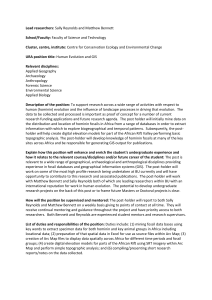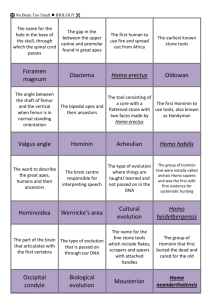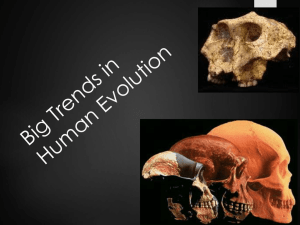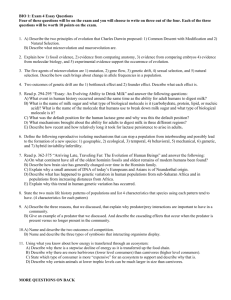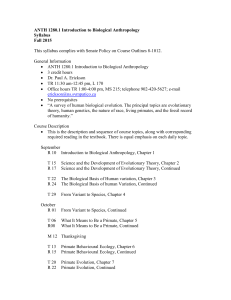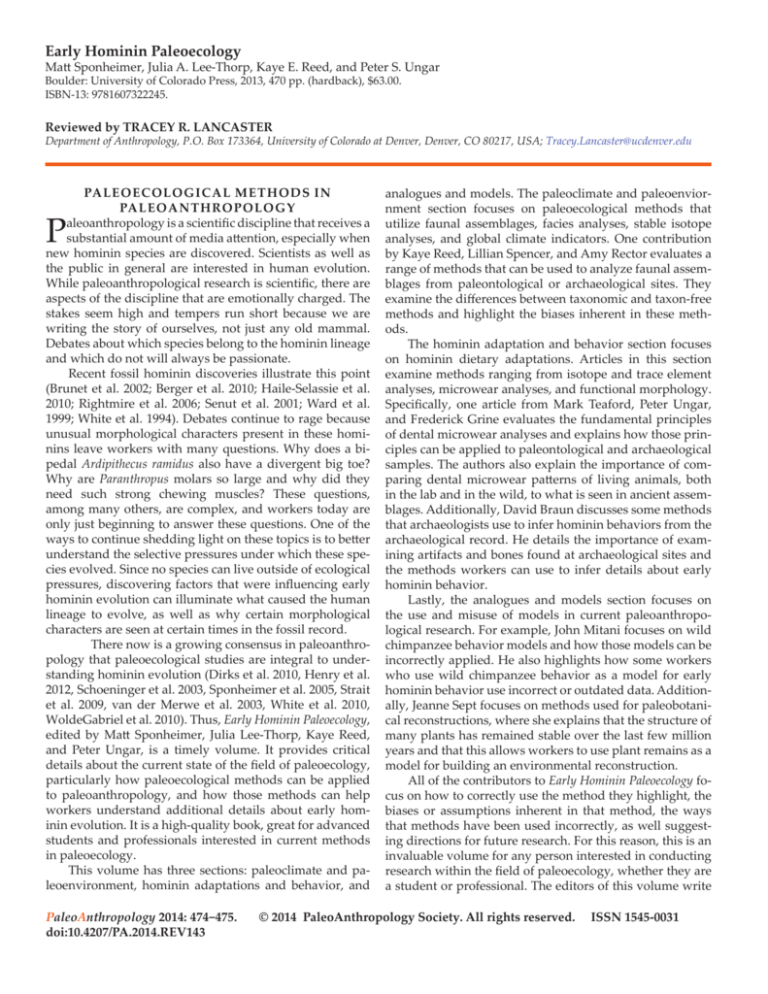
Early Hominin Paleoecology
Matt Sponheimer, Julia A. Lee-Thorp, Kaye E. Reed, and Peter S. Ungar
Boulder: University of Colorado Press, 2013, 470 pp. (hardback), $63.00.
ISBN-13: 9781607322245.
Reviewed by TRACEY R. LANCASTER
Department of Anthropology, P.O. Box 173364, University of Colorado at Denver, Denver, CO 80217, USA; Tracey.Lancaster@ucdenver.edu
PALEOECOLOGICAL METHODS IN
PALEOANTHROPOLOGY
aleoanthropology is a scientific discipline that receives a
substantial amount of media attention, especially when
new hominin species are discovered. Scientists as well as
the public in general are interested in human evolution.
While paleoanthropological research is scientific, there are
aspects of the discipline that are emotionally charged. The
stakes seem high and tempers run short because we are
writing the story of ourselves, not just any old mammal.
Debates about which species belong to the hominin lineage
and which do not will always be passionate.
Recent fossil hominin discoveries illustrate this point
(Brunet et al. 2002; Berger et al. 2010; Haile-Selassie et al.
2010; Rightmire et al. 2006; Senut et al. 2001; Ward et al.
1999; White et al. 1994). Debates continue to rage because
unusual morphological characters present in these hominins leave workers with many questions. Why does a bipedal Ardipithecus ramidus also have a divergent big toe?
Why are Paranthropus molars so large and why did they
need such strong chewing muscles? These questions,
among many others, are complex, and workers today are
only just beginning to answer these questions. One of the
ways to continue shedding light on these topics is to better
understand the selective pressures under which these species evolved. Since no species can live outside of ecological
pressures, discovering factors that were influencing early
hominin evolution can illuminate what caused the human
lineage to evolve, as well as why certain morphological
characters are seen at certain times in the fossil record.
There now is a growing consensus in paleoanthropology that paleoecological studies are integral to understanding hominin evolution (Dirks et al. 2010, Henry et al.
2012, Schoeninger et al. 2003, Sponheimer et al. 2005, Strait
et al. 2009, van der Merwe et al. 2003, White et al. 2010,
WoldeGabriel et al. 2010). Thus, Early Hominin Paleoecology,
edited by Matt Sponheimer, Julia Lee-Thorp, Kaye Reed,
and Peter Ungar, is a timely volume. It provides critical
details about the current state of the field of paleoecology,
particularly how paleoecological methods can be applied
to paleoanthropology, and how those methods can help
workers understand additional details about early hominin evolution. It is a high-quality book, great for advanced
students and professionals interested in current methods
in paleoecology.
This volume has three sections: paleoclimate and paleoenvironment, hominin adaptations and behavior, and
P
PaleoAnthropology 2014: 474−475.
doi:10.4207/PA.2014.REV143
analogues and models. The paleoclimate and paleoenviornment section focuses on paleoecological methods that
utilize faunal assemblages, facies analyses, stable isotope
analyses, and global climate indicators. One contribution
by Kaye Reed, Lillian Spencer, and Amy Rector evaluates a
range of methods that can be used to analyze faunal assemblages from paleontological or archaeological sites. They
examine the differences between taxonomic and taxon-free
methods and highlight the biases inherent in these methods.
The hominin adaptation and behavior section focuses
on hominin dietary adaptations. Articles in this section
examine methods ranging from isotope and trace element
analyses, microwear analyses, and functional morphology.
Specifically, one article from Mark Teaford, Peter Ungar,
and Frederick Grine evaluates the fundamental principles
of dental microwear analyses and explains how those principles can be applied to paleontological and archaeological
samples. The authors also explain the importance of comparing dental microwear patterns of living animals, both
in the lab and in the wild, to what is seen in ancient assemblages. Additionally, David Braun discusses some methods
that archaeologists use to infer hominin behaviors from the
archaeological record. He details the importance of examining artifacts and bones found at archaeological sites and
the methods workers can use to infer details about early
hominin behavior.
Lastly, the analogues and models section focuses on
the use and misuse of models in current paleoanthropological research. For example, John Mitani focuses on wild
chimpanzee behavior models and how those models can be
incorrectly applied. He also highlights how some workers
who use wild chimpanzee behavior as a model for early
hominin behavior use incorrect or outdated data. Additionally, Jeanne Sept focuses on methods used for paleobotanical reconstructions, where she explains that the structure of
many plants has remained stable over the last few million
years and that this allows workers to use plant remains as a
model for building an environmental reconstruction.
All of the contributors to Early Hominin Paleoecology focus on how to correctly use the method they highlight, the
biases or assumptions inherent in that method, the ways
that methods have been used incorrectly, as well suggesting directions for future research. For this reason, this is an
invaluable volume for any person interested in conducting
research within the field of paleoecology, whether they are
a student or professional. The editors of this volume write
© 2014 PaleoAnthropology Society. All rights reserved.
ISSN 1545-0031
BOOK REVIEW • 475
in the introduction that paleoecology is a dynamic and increasingly specialized field. Because of this increasing specialization, it is impossible for a single researcher to be an
expert in all of these methods. Thus, volumes such as this
are essential for those conducting research, as well as anyone who wishes to have a coherent understanding of the
state of the discipline at large. The editors of this volume
have shown how critical it is for workers to communicate
with one another in a way that others outside of their specialization can understand. They also show that it is possible for highly specialized scientists to work together to
highlight important details about hominin evolution.
Paleoecology has become an integral aspect of paleoanthropological research. As more hominins are added to the
growing fossil record, the number of studies conducting
paleoecological research will only increase. Thus, as new
hominin species are discovered and new data is published,
debates about hominin evolutionary history will continue.
These new discoveries will be published in many different media outlets, not just scientific journals. Publications
in the mainstream media make the debates about hominin
evolutionary history accessible to not just scientists, but
to the general public as well. It is important that human
evolution is shared with the general public, not just with
scientists within increasingly specialized disciplines, because human evolution is the story of all people. Because
new hominin discoveries cause such intense debates in the
field, it is incredibly important that workers today strive
to discern more details about the paleoecological pressures
that influenced the human lineage. It is only by discovering these paleoecological pressures that unusual morphological characters will begin to make more sense. It is for
that reason that this volume, Early Hominin Paleoecology, is
an extremely useful and timely volume for advanced students and professionals interested in learning more about
hominin paleobiology and frequently used paleoecological
methods.
REFERENCES
Brunet, M., Guy, F., Pilbeam, D., Mackaye, H.T., Likius, A.,
Ahounta, D., Beauvilain, A., Blondel, C., Bocherens, H.,
Bolsserle, J., De Bonis, L., Coppens, Y., Dejax, J., Denys,
C., Duringer, P., Elsenmann, V., Fanone, G., Fronty, P.,
Geraads, D., Lehmann, T., Lihoreau, F., Louchart, A.,
Mahamat, A., Merceron, G., Mouchelin, G., Otero, O.,
Campomanes, P., Ponce De Leon, M., Rage, J., Spanet,
M., Schuster, M., Sudre, J., Pascal, T., Valentin, X., Vignaud, P., Virlot, L,, Zazzo, A., and Zollikofer, C. 2002.
A new hominid from the Upper Miocene of Chad, Central Africa. Nature 418, 145–151.
Berger, L., de Ruiter, D., Churchill, S., Schmid, P., Carlson,
K., Dirks, P., and Kibii, J. 2010. Australopithecus sediba:
A new species of Homo-like Australopith from South
Africa. Science 328, 195–204.
Dirks, P., Kibii, J., Kuhn, B., Steininger, C., Churchill, S.,
Kramers, J., Pickering, R., Farber, D., Mériaux, A., Herries, A., King, G., and Berger, L. 2010. Geological Set-
ting and Age of Australopithecus sediba from Southern
Africa. Science 328, 205–208.
Haile-Selassie, Y., Saylor, B., Deino, A., Alene, M., and
Latimer, B. 2010. New hominid fossils from WoransoMille (Central Afar, Ethiopia) and taxonomy of early
Australopithecus. American Journal of Physical Anthropology 141, 406–417.
Henry, A., Ungar, P., Passey, B., Sponheimer, M., Rossouw,
L., Bamford, M., Sandberg, P., de Ruiter, D., and Berger, L. 2012. The diet of Australopithecus sediba. Nature
487, 90–93.
Rightmire, G., Lordkipanidze, D., and Vekua, A. 2006. Anatomical descriptions, compartive studies and evolutionary significance of the hominin skulls from Dmanisi, Republic of Georgia. Journal of Human Evolution 50,
115–141.
Senut, B., Pickford, M., Gommery, D., Mein, P., Chebio, K.,
and Coppens, Y. 2001. First hominid from the Miocene
(Lukeino Formation, Kenya). Earth and Planetary Sciences 332, 137–144.
Schoeninger, M., Reeser, H., and Hallin, K. 2003. Paleoenvironment of Australopithecus anamensis at Allia Bay, East
Turkana, Kenya: evidence from mammalian herbivore
enamel stable isotopes. Journal of Anthropological Archaeology 22, 200–207.
Sponheimer, M., Lee-Thorp, J., de Ruiter, D., Codron, D.,
Codron, J., Baugh, A., and Thackeray, F. 2005. Hominins, sedges, and termites: new carbon isotope data
from Sterkfontein valley and Kruger National Park.
Journal of Human Evolution 48, 301–312.
Strait, D., Weber, G., Neubauer, S., Chalk, J., Richmond, B.,
Lucas, P., Spencer, M., Schrein, C., Dechow, P., Ross,
C., Grosse, I., Wright, B., Constantino, P., Wood, B.,
Lawn, B., Hylander, W., Wang, Q., Byron, C., Slice, D.,
and Smith, A. 2009. The feeding biomechanis and dietary ecology of Australopithecus africanus. Proceedings
of the National Academy of Sciences 106, 2124–2129.
van der Merwe, N., Thackeray, J., Lee-Thorp, J., and Luyt,
J. 2003. The carbon isotope ecology and diet of Australopithecus africanus at Sterkfontein, South Africa. Journal
of Human Evolution 44, 581–597.
Ward, C., Leakey, M., and Walker, A. 1999. The new hominid species Australopithecus anamensis. Evolutionary Anthropology 7, 197–205.
White, T., Suwa, G., and Asfaw, B. 1994. Australopithecus
ramidus, a new species of early hominid from Aramis,
Ethiopia. Nature 371, 306–312.
White, T., Asfaw, B., Beyene, Y., Haile-Selassie, Y., Lovejoy,
C.O., Suwa, G., and WoldeGabriel, G. 2010. Ardipithecus ramidus and the Paleobiology of Early Hominids.
Science 326, 75–86.
WoldeGabriel, G., Ambrose, S., Barboni, D., Bonnefille, R.,
Bremond, L., Currie, B., DeGusta, D., Hart, W., Murray,
A., Renne, P., Jolly-Saad, M., Stewart, K., and White, T.
2010. The Geological, Isotopic, Botanical, Invertebrate,
and Lower Vertebrate Surroundings of Ardipithecus
ramidus. Science 326, 65e1–65e5.

